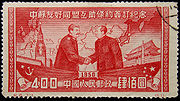
Sino-Soviet Treaty of Friendship
Encyclopedia

China
Chinese civilization may refer to:* China for more general discussion of the country.* Chinese culture* Greater China, the transnational community of ethnic Chinese.* History of China* Sinosphere, the area historically affected by Chinese culture...
and the Soviet Union
Soviet Union
The Soviet Union , officially the Union of Soviet Socialist Republics , was a constitutionally socialist state that existed in Eurasia between 1922 and 1991....
on February 14, 1950. It was based to a considerable extent on the prior Treaty of the same name that had been arranged between the Soviet Union and the Nationalist government in 1945 and it was the product of extended negotiations between Liu Shaoqi and Stalin. Mao travelled to the Soviet Union in order to sign the Treaty after its details had been concluded and this was the only time that he travelled outside China for the duration of his life. The Treaty dealt with a range of issues such as Soviet privileges in Xinjiang and Manchuria and one of its most important points was the provision of a $300 million loan from the Soviet Union to the People's Republic, which had suffered economically and logistically from over a decade of intense warfare. The treaty did not prevent relations between Beijing
Beijing
Beijing , also known as Peking , is the capital of the People's Republic of China and one of the most populous cities in the world, with a population of 19,612,368 as of 2010. The city is the country's political, cultural, and educational center, and home to the headquarters for most of China's...
and Moscow from drastic deterioration in the late 1950s - early 1960s, at the time of the Sino–Soviet split. In light of opening up China to the international market and the expiration of the Treaty, Deng Xiaoping wanted China not to negotiate with the Soviets unless they agreed to China's demands. Those were that the Soviets retreated from Afghanistan, removed their troops from Mongolia and Sino–Soviet borders and stopped supporting Vietnam's invasion of Cambodia. The treaty expired in 1979, which allowed China to attack Vietnam, a Soviet ally, in the Third Indochina War as a response to Vietnam's invasion of Cambodia, as the treaty had prevented China from attacking Soviet allies.
See also
- Sino-Soviet Non-Aggression Pact
- Sino-Soviet border conflictSino-Soviet border conflictThe Sino–Soviet border conflict was a seven-month military conflict between the Soviet Union and China at the height of the Sino–Soviet split in 1969. The most serious of these border clashes occurred in March 1969 in the vicinity of Zhenbao Island on the Ussuri River, also known as Damanskii...
- 2001 Sino-Russian Treaty of Friendship2001 Sino-Russian Treaty of FriendshipThe Treaty of Good-Neighborliness and Friendly Cooperation Between the People's Republic of China and the Russian Federation is a twenty-year strategic treaty which was signed by the leaders of the two international powers, Jiang Zemin and Vladimir Putin, on July 16, 2001.-Overview:The treaty...
External links
- An article from the PRCPeople's Republic of ChinaChina , officially the People's Republic of China , is the most populous country in the world, with over 1.3 billion citizens. Located in East Asia, the country covers approximately 9.6 million square kilometres...
ministry of foreign relations on the treaty. - An article which mentions the treaty.
- Yang Kuisong, (2005), Parallel History ProjectParallel History ProjectThe Parallel History Project on Cooperative Security is an open source website reference compilation, research project, and analysis nexus sparked by the progressive increase in the declassification of NATO and Soviet bloc documents related to Cold War activities, as viewed by both sides...
(PHP).

